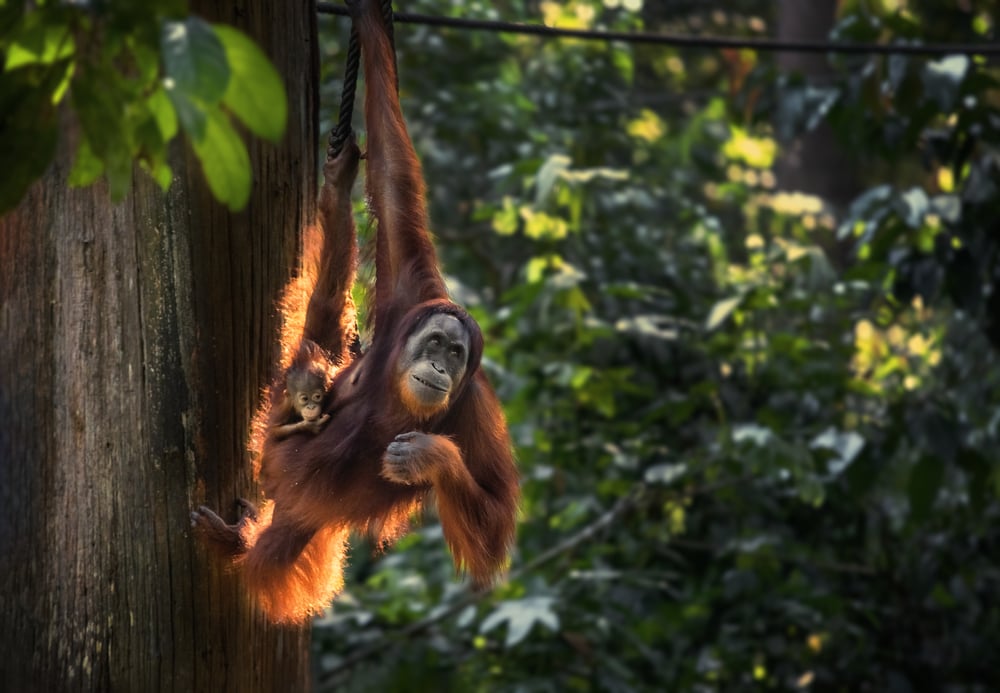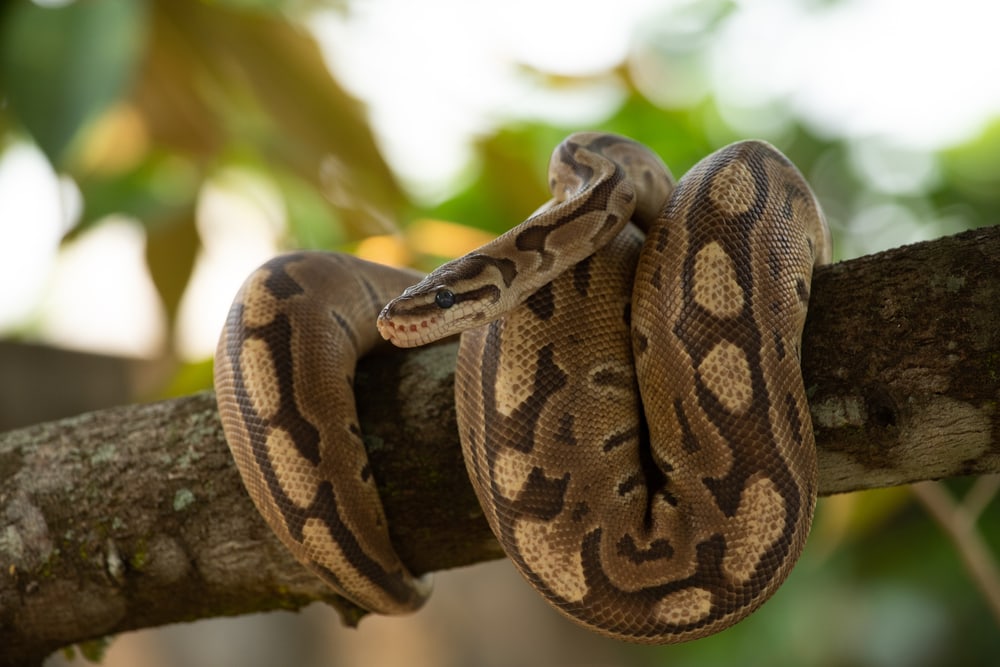Outforia Key Takeaways:
- Tree-dwelling or arboreal animals have evolved unique adaptations, such as opposable thumbs or the ability to fly, for life above ground and to consume the food available on trees.
- Animals like lizards, bears, caterpillars, bats, monkeys, apes, owls, squirrels, foxes, snakes, salamanders, spiders, and hawks are known to dwell on trees.
- The habitat of an animal within the tree depends on its specific needs and adaptations; some live in holes inside trunks, some under the bark, some make nests, and some cling onto branches.
- Some of the most biologically diverse forests in the world are Amazon Rainforest (Ecuador and Brazil), Corcovado National Park and Monteverde Cloud Forest (Costa Rica), Valdivian Forest (Central Chile), and Papua New Guinea Rainforests.
- The fastest arboreal animal is the Gibbon, which can move at 35 mph (56 kph); the largest is the orangutan, with males weighing up to 183 lb (83 kg); and the rarest arboreal animals include Aye-ayes and Goodfellow’s Tree Kangaroo.

Arboreal animals are tree-dwelling animals. They have adapted to a life above the ground in various ways. Some have strongly gripping opposable thumbs, like monkeys. This helps them grip the branches. Others, like the bat, can fly.
Trees are full of food, too. So these animals are best placed to make use of the bounty of nuts, berries, mushrooms, fungi, and lichens, as well as the wood and leaves of the tree.
Trees protect the creatures within them from weather conditions like storms and drought.
Check out the arboreal animals below—some might surprise you.
1. Lizards

Lizards are reptiles in the order Squamata. This also includes snakes, which are distinct from lizards with their own suborder, Serpentes. Lizards have legs, movable eyelids, and ear openings visible on their bodies. This is not a hard rule, as some lizards have lost their legs, such as slow worms. Some species of skinks and geckos have no eyelids.
Lizards evolved before snakes. All snakes are descended from lizards. There are 5,500 species of lizards worldwide.
Lizards are cold-blooded. This means the best places to find them are in temperate or hot climates. Here they can bask in the sun to help them gain energy to move. They are very adaptable, however, with a few species found near the Arctic Circle in Eurasia.
2. Bears

Bears have thick hair and sharp claws. They are generally large and heavy. They can stand on two legs like humans. All bears are in the family Ursidae. Within this is the subfamily Ursinae, which includes all bears except for the Giant Panda and the Spectacled Bear.
Bears are omnivorous, which means they eat a wide variety of things, including meat, fruit, and vegetables. The smallest bear, the Sun Bear, weighs 60 lbs (27 kg). While the largest, the Polar Bear, weighs 1,600 lbs (726 kg),
Bears have non-retractable claws and a great sense of smell. They are solitary animals, only coming together to mate. The female bear is slightly more social as she looks after the cubs. There are eight different types of bears.
3. Caterpillar

Caterpillars are the larvae of butterflies, skippers, and moths. They are known for their metamorphosis into adult winged insects. To do this, they go into a dormant state. They pupate inside a cocoon, or pupa.
Caterpillars are still insects, even if they don’t look like insects with their fat, soft bodies and many legs. This is because they are the larvae of an insect.
Caterpillars are usually herbivorous, though some caterpillars will feed on their own mothers, as in the case of the Bagworm moth. Most of the insect’s feeding happens in the larval stage, with many adult butterflies and moths unable to feed.
4. Bats

There are 28 types of bats, including horseshoe bats, fruit bats, and flying foxes. There are 1,400 species of bats that fit into these 28 categories. Bats are the only true flying mammals.
You can find bats on every continent except Antarctica, the Arctic, and a very small number of the more isolated Oceanic Islands. There are even bats in Northern Scandinavia. The best place to find bats is in the tropics, though. Indonesia alone has 175 species of bats living in the wild.
Many bats are carnivorous, eating insects. The Vampire Bat even drinks blood. These bats often use echolocation to detect prey. Not all bats have this ability. Fruit bats feed on forest fruits and do not need to use echolocation.
5. Monkeys

Monkeys are tailed primates. There are over 200 species of monkeys. This doesn’t include lemurs, lorises, and tarsiers. Monkeys have narrow chests, as opposed to their larger cousins, the apes. They normally have flat faces, although baboons don’t.
Monkeys are most often tree dwellers. They are omnivorous, like us. They have thumbs, which they can manipulate to hold things and use as tools. They are very intelligent creatures, though not to the level of the great apes. They are able to solve problems easily.
Monkeys are active during the day. They are found most often in forests in tropical regions. Here you will find them in troops, as they are very social animals.
6. Apes

Apes are tailed primates of the families Hylobatidae and Hominidae. Gibbons are the only members of the Hylobatidae. All other apes, such as chimpanzees, gorillas, bonobos, orangutans, and humans, belong to the family Hominidae.
Gibbons are known as lesser apes. They are not as intelligent as the great apes. Apes also have an appendix. Monkeys don’t.
Apes like to sleep in trees, or at the very least near the base of them in the case of the male orangutan. He is too heavy to sleep in the trees. Fruit comprises much of an ape’s diet, but they will also eat insects. Chimpanzees are active hunters of monkeys.
7. Owls

Owls are from the family Strigiformes. They are nocturnal or crepuscular raptors—birds of prey. They feed on smaller animals. Most often, their prey is rodents. The smaller owls eat insects. Crepuscular means they are active at dusk and dawn.
Owl characteristics include a flat face with large, well-developed forward-facing eyes and a small beak. They have powerful feet with sharp talons. They have short tails and rounded wings.
Owls can be found all over the world except Antarctica and some Oceanic Islands. Owls are successful birds due to their being nocturnal. This keeps them out of sight of humans. Some owls have territories, while others are nomadic.
8. Squirrels

Squirrels are from the Sciuridae family of mammals. There are 200 species of squirrels worldwide. You won’t find them in Australia, however. Many squirrels live in trees, but there are also ground squirrels and even a flying squirrel.
Squirrels are rodents. Like other rodents, they have four powerful front teeth that don’t stop growing. They chew hard objects regularly to keep their teeth trim. Ground squirrels eat plant matter and some insects. Tree squirrels eat nuts and berries, but also eggs and baby birds.
What sets squirrels apart from other rodents is their bushy tail. They use this to aid in balance in the treetops. Ground squirrels still have a furry tail, but it’s thinner.
9. Foxes

Foxes are good climbers, though not all of them live in trees. The North American Gray Fox has its den high up in the trunk of a tree. Foxes can be found on almost every continent; even the Arctic has its own Fox. They are not present in Antarctica (like almost everything else).
True foxes belong to the genus Vulpes. They are small canids with bushy tails, long fur, and narrow muzzles. They are most often active at dawn and dusk or throughout the night, unlike dogs.
Foxes are omnivorous, though a lot of their diet is carnivorous. They will eat fruit and berries as well as rodents, birds, eggs, insects, and earthworms. They will also eat takeout out of dustbins. They are intelligent creatures and live in family groups.
10. Snakes

Snakes are a suborder of the Squamata order of reptiles. They have a forked tongue and scales and are cold-blooded. They also have no legs. They don’t hear through ear holes. Instead, they sense vibrations through special bones on the underside of their lower jaw.
There are over 3,000 species. They live anywhere the climate can support their cold-blooded metabolism. This means you can find them anywhere except Iceland, Greenland, the Antarctic, and, strangely enough, New Zealand and Ireland.
People can be terrified of snakes, but only 600 of these 3000 species are poisonous. Only 200 of these have the capacity to seriously wound or kill a human. Snakes are carnivorous and feed on prey ranging from eggs to antelope. There are even snakes that eat other snakes.
11. Salamanders

Salamanders, climbing trees? Yes. Those soft-skinned, amphibious creatures don’t all live in trees, but some do. The Arboreal Salamander of California can climb up to 60 feet (8.2 m) from the ground using its prehensile tail and gripping toes.
Salamanders are defined by their soft, permeable skin and long bodies with short limbs. They are found near or in water, as they can breathe underwater through their skin. They need moisture, or they will dry out.
In medieval times, salamanders were believed to live in fire. They were regarded as magical creatures. This is the opposite of the truth—the last thing a moisture-loving salamander wants to be near is fire.
12. Spiders

Spiders are arachnids. They breathe air and have eight legs. Scorpions and ticks are also arachnids. There are 45,000 species of spiders in the world. Most are carnivorous and predate on insects. The Goliath Bird-Eating Spider eats small fish, mice, and birds, however.
Spiders fulfill an important function in the food web. They keep the number of insects under control. Most spiders are not dangerous to humans. Spiders have spinnerets that produce silk. They use this to make webs or silk-lined burrows and to wrap up their eggs.
Spiders are from the order Araneae. They have mouthparts called chelicerae. These are able to inject venom using sharp fangs. The male spider uses his chelicerae to copulate with the female.
13. Hawks

Hawks are small to medium-sized accipitriform birds. These are day-flying birds of prey. The bird family Accipitridae includes kites, harriers, and buzzards, but these are not true hawks. True hawks are from the genus Accipiter.
You can find hawks everywhere except Antarctica. They are known as arboreal species because most hawks nest in trees. They will eat mammals, birds, reptiles, and insects. The Osprey is a specialist feeder on fish.
Hawks have forward-facing, large eyes with very good eyesight. Hence the saying “eyes like a hawk”. They have strong talons. They kill their prey by beheading and dismembering it.
You may also like: 25 Unique Coral Reef Animals That Live In Diverse Ecosystems
Where Do Animals Live in Trees?

Where an animal lives in a tree depends on what conditions it needs and what its adaptations are. There are different trophic levels in a forest, too. We will go into those after this.
- Holes in the trunk: Some animals live in holes dug out of or found in tree trunks. This includes the Gray Fox, which comes from the US.
Mandarin ducks nest in tree trunks. The ducklings take a leap of faith when they are ready. Many birds, such as woodpeckers, nest in tree trunks.
- Glued to leaves: caterpillars glue themselves to the undersides of leaves when they are ready to pupate. The adult butterflies and moths lay their eggs on leaves.
Gall wasps lay their eggs inside leaves and seeds on trees. The tree reacts to this by producing a gall, which protects and nourishes the wasp larva.
- Nests: not only birds but also primates like apes and monkeys make nests in trees. It’s much safer than sleeping on the ground, where predators lurk.
Some of the predators have adapted to this and now climb trees. Wasps and bees prefer to be high in a tree too.
- Under the bark: insect grubs hide and eat under the bark of trees, protected from predators. Until a predator that is adapted to get them out digs them out – like a woodpecker.
- Clinging to branches: animals with strong tails and flexible digits use them to tightly grip branches.
Sloths sleep upside down hanging onto branches. Stick insects and thorn bugs cling to branches, looking just like a twig or thorn themselves.
The Most Biologically Diverse Forests on Earth
Here’s the lowdown on the most species-rich forests on Earth. Maybe one of these could be your next trip out?
Amazon Rainforest, Ecuador and Brazil

Unsurprisingly, the Amazon rainforest was proven by a study from The Department of Ecology at Charles University to be one of the most diverse places on Earth.
Over 200 tree species were found per hectare of rainforest. Tropical rainforests have a higher diversity of species than temperate forests. Plus far more than boreal forests.
The more tree species there are, the more animal species have adapted to live on these trees. 15% of the world’s bird and butterfly species live in the Amazon. It hosts 427 mammal species, 378 reptile species, and 400 species of amphibians.
The Amazon is threatened by land clearance for cattle ranching, mining, oil drilling, and soybean monocultures.
Corcovado National Park and Monteverde Cloud Forest, Costa Rica
Costa Rica’s tropical jungle is also a hotbed of species. Half a million species of animals, fungi, and plants live here. That’s equal to 5% of all species on Earth.
The piece of Central America that is Costa Rica makes up only 0.03% of the world’s land mass. This shows just how richly diverse it is.
Costa Rica is located on a land bridge known as the Isthmus of Panama. This joins North and South America, allowing an influx of species from both sides.
The weather is humid and wet on the Atlantic side of Costa Rica. On the Pacific side, it is both wet and dry depending on the season. Due to the land’s formation by a chain of volcanoes, the soils are volcanic and rich.
This means more diversity as species adapt to each condition. Threats to Costa Rica’s forests include deforestation. Monocultures of plants like coffee and cattle ranching are to blame for this.
Valdivian Forest, Central Chile

The most species-rich temperate forest in the world was found to be in the middle of Chile. This forest has 50 species of trees per hectare. Far less than tropical forests, but a respectable number of species
The Valdivian Forest is the only temperate forest in South America.
The Valdivian Forest is home to the Alerce tree, one of the largest, oldest, and most majestic in the world. Some of these trees are 3,000 years old. The forest contains 122 species of vascula plants.
Many animal species are endemic to Chile. They exist only in Chile’s forests and nowhere else. These include the Chilean guemal (Hippocamelus bisulcus), the kodkod (Oncifelis guigna), and the Southern Pudu (Pudu puda).
Logging and clearing land for plantations are the biggest threats to the Chilean temperate rainforest today.
Papua New Guinea Rainforests

Papua New Guinea has incredible species diversity, due in part to its range of climates. There is a glacier, Puncak Jaya, at more than 5,000 m above sea level.
Due to this, there are cooler areas of the island and snowstorms. There are also hot and humid forests with enormous rainstorms.
Because of Papua New Guinea’s mountainous topography, there are two distinct types of rainforest. These are lowland rainforests and montane forests. The forests cover 65% of the land area.
Papua New Guinea has one tenth of the land area of Australia. It also has the same number of species. All the world’s bird of paradise species live here. Plus most of the tree kangaroos.
You may also like: Nature’s Alphabet: A List Of Animals That Start With N
Animals That Live in Trees FAQs

What is the fastest arboreal animal?
The gibbon, a type of lesser ape, can travel through the forest canopy at 35 miles per hour (56 kph). It swings forward and catches hold of branches with its long arms. Gibbons must be fast to outrun hawks, snakes, and leopards.
What are arboreal animals?
Arboreal animals are animals that live in trees. They have adapted to life above the ground.
Within the arboreal zone of trees, there are several levels, such as the canopy and the understory. Animals tend to stay at certain levels where they are adapted for changing conditions, for example, from bright sunlight to darkness.
What is the biggest arboreal animal?
The Orang-utan great ape of Borneo and Sumatra is the largest and heaviest tree-dwelling animal. The male weighs in at 83 kg (183 lb). The female is lighter, at 37 kg (81 lb).
The male measures 1.5 m (5 ft) tall. His arm span stretches to 2 meters. As he is so much heavier, he sleeps in a nest on the ground; females sleep in the trees.
What is the rarest arboreal animal?
Aye-ayes are one of the rarest tree-dwelling animals. They are endemic to Madagascar. They are found at only a few sites on the island.
The Goodfellow’s Tree Kangaroo is another very rare species. It is found only in the rainforests of Papua New Guinea.









